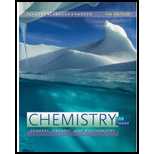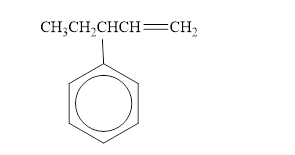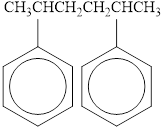
Bundle: Chemistry for Today: General, Organic, and Biochemistry, Loose-Leaf Version, 9th + LMS Integrated OWLv2, 4 terms (24 months) Printed Access Card
9th Edition
ISBN: 9781337598255
Author: Spencer L. Seager
Publisher: Cengage Learning
expand_more
expand_more
format_list_bulleted
Concept explainers
Textbook Question
Chapter 12, Problem 12.54E
Give an IUPAC name for the following as hydrocarbons with the benzene ring as a substituent:
a. 
b. 
Expert Solution & Answer
Trending nowThis is a popular solution!

Students have asked these similar questions
Solve this
く
Predicting the pr
Predict the major products of the following organic reaction:
Δ
Some important notes:
• Draw the major product, or products, of the reaction in the drawing area below.
• If there aren't any products, because no reaction will take place, check the box below the drawing area instead.
• Be sure to use wedge and dash bonds when necessary, for example to distinguish between major products that are
enantiomers.
?
Click and drag to start drawing a structure.
propose synthesis
Chapter 12 Solutions
Bundle: Chemistry for Today: General, Organic, and Biochemistry, Loose-Leaf Version, 9th + LMS Integrated OWLv2, 4 terms (24 months) Printed Access Card
Ch. 12 - Prob. 12.1ECh. 12 - Define the terms alkene, alkyne, and aromatic...Ch. 12 - Select those compounds that can be correctly...Ch. 12 - Prob. 12.4ECh. 12 - Give the IUPAC name for the following compounds:...Ch. 12 - Prob. 12.6ECh. 12 - Prob. 12.7ECh. 12 - Prob. 12.8ECh. 12 - Prob. 12.9ECh. 12 - Prob. 12.10E
Ch. 12 - Prob. 12.11ECh. 12 - Prob. 12.12ECh. 12 - What type of hybridized orbital is present on...Ch. 12 - What type of orbital overlaps to form a pi bond in...Ch. 12 - Prob. 12.15ECh. 12 - Explain the difference between geometric and...Ch. 12 - Draw structural formulas and give IUPAC names for...Ch. 12 - Prob. 12.18ECh. 12 - Which of the following alkenes can exist as...Ch. 12 - Draw structural formulas for the following:...Ch. 12 - Prob. 12.21ECh. 12 - In what ways are the physical properties of...Ch. 12 - Prob. 12.23ECh. 12 - Prob. 12.24ECh. 12 - Complete the following reactions. Where more than...Ch. 12 - Prob. 12.26ECh. 12 - Prob. 12.27ECh. 12 - What reagents would you use to prepare each of the...Ch. 12 - What is an important commercial application of...Ch. 12 - Prob. 12.30ECh. 12 - Terpin hydrate is used medicinally as an...Ch. 12 - Prob. 12.32ECh. 12 - Prob. 12.33ECh. 12 - Prob. 12.34ECh. 12 - Prob. 12.35ECh. 12 - Much of todays plumbing in newly built homes is...Ch. 12 - Prob. 12.37ECh. 12 - What type of hybridized orbital is present on...Ch. 12 - How many sigma bonds and how many pi bonds make up...Ch. 12 - Prob. 12.40ECh. 12 - Explain why geometric isomerism is not possible in...Ch. 12 - Give the common name and major uses of the...Ch. 12 - Describe the physical and chemical properties of...Ch. 12 - Prob. 12.44ECh. 12 - Prob. 12.45ECh. 12 - Prob. 12.46ECh. 12 - Prob. 12.47ECh. 12 - Prob. 12.48ECh. 12 - Limonene, which is present in citrus peelings, has...Ch. 12 - A disubstituted cycloalkane such as a exhibits...Ch. 12 - Prob. 12.51ECh. 12 - Prob. 12.52ECh. 12 - Give an IUPAC name for the following as...Ch. 12 - Give an IUPAC name for the following as...Ch. 12 - Name the following compounds, using the prefixed...Ch. 12 - Name the following compounds, using the prefixed...Ch. 12 - Name the following by numbering the benzene ring....Ch. 12 - Name the following by numbering the benzene ring....Ch. 12 - Prob. 12.59ECh. 12 - Write structural formulas for the following:...Ch. 12 - Prob. 12.61ECh. 12 - Prob. 12.62ECh. 12 - Prob. 12.63ECh. 12 - Prob. 12.64ECh. 12 - Prob. 12.65ECh. 12 - Prob. 12.66ECh. 12 - Prob. 12.67ECh. 12 - Prob. 12.68ECh. 12 - Prob. 12.69ECh. 12 - Prob. 12.70ECh. 12 - Prob. 12.71ECh. 12 - Prob. 12.72ECh. 12 - Prob. 12.73ECh. 12 - Prob. 12.74ECh. 12 - Prob. 12.75ECh. 12 - Prob. 12.76ECh. 12 - Prob. 12.77ECh. 12 - Prob. 12.78ECh. 12 - Prob. 12.79ECh. 12 - Prob. 12.80ECh. 12 - Prob. 12.81ECh. 12 - Prob. 12.82ECh. 12 - Prob. 12.83ECh. 12 - The compound CH2=CHCH2CH2CH3 is an example of: a....Ch. 12 - The correct structural for ethyne is: a. HC=CH b....Ch. 12 - Prob. 12.86E
Knowledge Booster
Learn more about
Need a deep-dive on the concept behind this application? Look no further. Learn more about this topic, chemistry and related others by exploring similar questions and additional content below.Similar questions
- Explanation O Conjugated Pi Systems Deducing the reactants of a Diels-Alder reaction Can the molecule on the right-hand side of this organic reaction be made in good yield from no more than two reactants, in one step, by moderately heating the reactants? ? Δ If your answer is yes, then draw the reactant or reactants in the drawing area below. You can draw the reactants in any arrangement you like. • If your answer is no, check the box under the drawing area instead. Click and drag to start drawing a structure. Xarrow_forwardDiels Alder Cycloaddition: Focus on regiochemistry (problems E-F) –> match + of thedienophile and - of the diene while also considering stereochemistry (endo).arrow_forwardHELP! URGENT! PLEASE RESOND ASAP!arrow_forward
- Question 4 Determine the rate order and rate constant for sucrose hydrolysis. Time (hours) [C6H12O6] 0 0.501 0.500 0.451 1.00 0.404 1.50 0.363 3.00 0.267 First-order, k = 0.210 hour 1 First-order, k = 0.0912 hour 1 O Second-order, k = 0.590 M1 hour 1 O Zero-order, k = 0.0770 M/hour O Zero-order, k = 0.4896 M/hour O Second-order, k = 1.93 M-1-hour 1 10 ptsarrow_forwardDetermine the rate order and rate constant for sucrose hydrolysis. Time (hours) [C6H12O6] 0 0.501 0.500 0.451 1.00 0.404 1.50 0.363 3.00 0.267arrow_forwardDraw the products of the reaction shown below. Use wedge and dash bonds to indicate stereochemistry. Ignore inorganic byproducts. OSO4 (cat) (CH3)3COOH Select to Draw ઘarrow_forward
- Calculate the reaction rate for selenious acid, H2SeO3, if 0.1150 M I-1 decreases to 0.0770 M in 12.0 minutes. H2SeO3(aq) + 6I-1(aq) + 4H+1(aq) ⟶ Se(s) + 2I3-1(aq) + 3H2O(l)arrow_forwardProblem 5-31 Which of the following objects are chiral? (a) A basketball (d) A golf club (b) A fork (c) A wine glass (e) A spiral staircase (f) A snowflake Problem 5-32 Which of the following compounds are chiral? Draw them, and label the chirality centers. (a) 2,4-Dimethylheptane (b) 5-Ethyl-3,3-dimethylheptane (c) cis-1,4-Dichlorocyclohexane Problem 5-33 Draw chiral molecules that meet the following descriptions: (a) A chloroalkane, C5H11Cl (c) An alkene, C6H12 (b) An alcohol, C6H140 (d) An alkane, C8H18 Problem 5-36 Erythronolide B is the biological precursor of erythromycin, a broad-spectrum antibiotic. How H3C CH3 many chirality centers does erythronolide B have? OH Identify them. H3C -CH3 OH Erythronolide B H3C. H3C. OH OH CH3arrow_forwardPLEASE HELP! URGENT! PLEASE RESPOND!arrow_forward
- 2. Propose a mechanism for this reaction. ہلی سے ملی N H (excess)arrow_forwardSteps and explanationn please.arrow_forwardProblem 5-48 Assign R or S configurations to the chirality centers in ascorbic acid (vitamin C). OH H OH HO CH2OH Ascorbic acid O H Problem 5-49 Assign R or S stereochemistry to the chirality centers in the following Newman projections: H Cl H CH3 H3C. OH H3C (a) H H H3C (b) CH3 H Problem 5-52 Draw the meso form of each of the following molecules, and indicate the plane of symmetry in each: OH OH (a) CH3CHCH2CH2CHCH3 CH3 H3C. -OH (c) H3C CH3 (b) Problem 5-66 Assign R or S configurations to the chiral centers in cephalexin, trade-named Keflex, the most widely prescribed antibiotic in the United States. H2N H IHH S Cephalexin N. CH3 CO₂Harrow_forward
arrow_back_ios
SEE MORE QUESTIONS
arrow_forward_ios
Recommended textbooks for you
 Chemistry for Today: General, Organic, and Bioche...ChemistryISBN:9781305960060Author:Spencer L. Seager, Michael R. Slabaugh, Maren S. HansenPublisher:Cengage Learning
Chemistry for Today: General, Organic, and Bioche...ChemistryISBN:9781305960060Author:Spencer L. Seager, Michael R. Slabaugh, Maren S. HansenPublisher:Cengage Learning Introductory Chemistry: An Active Learning Approa...ChemistryISBN:9781305079250Author:Mark S. Cracolice, Ed PetersPublisher:Cengage Learning
Introductory Chemistry: An Active Learning Approa...ChemistryISBN:9781305079250Author:Mark S. Cracolice, Ed PetersPublisher:Cengage Learning Organic And Biological ChemistryChemistryISBN:9781305081079Author:STOKER, H. Stephen (howard Stephen)Publisher:Cengage Learning,
Organic And Biological ChemistryChemistryISBN:9781305081079Author:STOKER, H. Stephen (howard Stephen)Publisher:Cengage Learning, General, Organic, and Biological ChemistryChemistryISBN:9781285853918Author:H. Stephen StokerPublisher:Cengage Learning
General, Organic, and Biological ChemistryChemistryISBN:9781285853918Author:H. Stephen StokerPublisher:Cengage Learning

Chemistry for Today: General, Organic, and Bioche...
Chemistry
ISBN:9781305960060
Author:Spencer L. Seager, Michael R. Slabaugh, Maren S. Hansen
Publisher:Cengage Learning


Introductory Chemistry: An Active Learning Approa...
Chemistry
ISBN:9781305079250
Author:Mark S. Cracolice, Ed Peters
Publisher:Cengage Learning

Organic And Biological Chemistry
Chemistry
ISBN:9781305081079
Author:STOKER, H. Stephen (howard Stephen)
Publisher:Cengage Learning,

General, Organic, and Biological Chemistry
Chemistry
ISBN:9781285853918
Author:H. Stephen Stoker
Publisher:Cengage Learning

Chapter 4 Alkanes and Cycloalkanes Lesson 2; Author: Linda Hanson;https://www.youtube.com/watch?v=AL_CM_Btef4;License: Standard YouTube License, CC-BY
Chapter 4 Alkanes and Cycloalkanes Lesson 1; Author: Linda Hanson;https://www.youtube.com/watch?v=PPIa6EHJMJw;License: Standard Youtube License